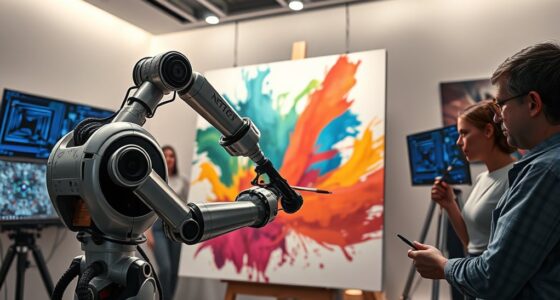Automation disproportionately impacts women in the workforce, especially in roles like administrative support and office jobs where women are overrepresented. In many countries, women face higher risks of job displacement due to AI, with over 11% at very high risk compared to men. This gender gap is driven by occupational segregation and resource disparities across regions. Understanding these hidden inequalities helps reveal how automation deepens existing gender divides—explore further to learn more about this surprising shift.
Key Takeaways
- Women are disproportionately exposed to automation risks, especially in administrative and support roles, deepening gender inequalities.
- Occupational segregation causes women to be overrepresented in jobs vulnerable to AI-driven displacement.
- Geographic disparities and limited resources in lower-income countries worsen women’s vulnerability to automation impacts.
- Automation may influence the gender employment gap, potentially reducing it if male-dominated sectors face higher job losses.
- Addressing the gendered nature of automation exposure is crucial for developing equitable policies and preventing increased inequality.

Have you ever considered how automation might be quietly widening gender divides in the workforce? As new technologies like generative AI become more prevalent, women find themselves disproportionately exposed to job automation risks. In high-income countries, nearly 10% of female employment faces high exposure to AI automation, compared to just 3.5% of men. Globally, about a quarter of jobs are affected by some level of AI influence, but women are hit harder because they tend to work in occupations more vulnerable to automation, especially in office and administrative support roles. This concentrated presence in certain sectors means women often face both the highest and lowest risks, depending on their specific job tasks. For example, administrative assistants and secretaries are highly susceptible to AI-driven automation, while other female-dominated roles might have lower exposure, but overall, the gendered occupational landscape increases the likelihood of displacement for women. Additionally, the specific tasks within these roles—whether routine or complex—play a critical role in determining automation susceptibility, emphasizing the importance of analyzing job functions alongside gender.
Geography adds another layer of disparity. In wealthier nations, automation exposure is much higher—around 34%—compared to just 11% in lower-income countries. However, lower-income regions often lack the resources needed for effective workforce transitions, leaving women in these areas vulnerable without adequate social safety nets. The structure of local economies and industries influences how automation impacts women differently across nations. In developed countries, technological advancement accelerates automation, but in developing regions, fewer resources hinder adaptation efforts, which could trap women in vulnerable jobs longer. Additionally, digital infrastructure disparities, such as limited internet access, further restrict women’s ability to participate in AI-driven economic opportunities, exacerbating existing inequalities. These disparities highlight the crucial role of digital infrastructure in shaping how automation affects women globally.
Occupational segregation plays a critical role in this gendered automation risk. Women are overrepresented in roles like administrative support, which face high chances of AI replacement. Conversely, some male-dominated roles, such as machine operators, also face automation threats but often at a higher rate. This means women are caught in a paradox: they occupy jobs at both ends of the automation risk spectrum. The specific tasks within these roles—whether routine or complex—determine how likely AI is to substitute human workers, emphasizing the importance of analyzing job functions alongside gender. Recognizing these nuanced differences can help tailor policies to mitigate displacement risks effectively. Automation could also influence the gender employment gap. If automation accelerates job losses primarily in male-dominated fields, it might narrow this gap by 2030. However, slower adoption would lead to more gradual, evenly spread job losses, reducing the potential for rapid gender shifts. While employment policies can offer some protection, they only mildly mitigate the impact of automation on gender disparities. Ultimately, long-term effects remain uncertain, but automation’s influence on gender dynamics could reshape the workforce, reinforcing existing divides or creating new opportunities for equality. In fact, studies show that gendered occupational segregation contributes significantly to differential automation risks across sectors. Women face about a 40% chance of automation, slightly higher than men’s probability. Nearly 11% of women are at very high risk—more than those among men—highlighting a significant gender difference in the potential for displacement. Across countries, these disparities are statistically significant, and individual data confirms women are more likely to be displaced by automation in the coming decades. Recognizing this hidden gender gap is vital for developing policies and strategies that guarantee automation advances do not further entrench inequality but instead create a more equitable future for everyone.
Frequently Asked Questions
How Does Automation Impact Gender Pay Disparities?
You might think automation levels the playing field, but it often widens gender pay disparities. Automation tends to benefit male wages more, especially in manufacturing and service sectors, while female wages lag behind. Certain technologies, like computer capital, worsen the gap, whereas industrial robots can reduce it. Without targeted efforts, automation can reinforce occupational segregation and existing inequalities, making it harder for women to achieve pay equity.
Are Women More Likely to Be Displaced by Automation Than Men?
You might think women are more likely to be displaced by automation, and the data backs this up. Women face nearly three times the risk of automation compared to men, especially in high-risk jobs. This means that, in many sectors, women are more vulnerable to job loss as machines take over. Staying proactive and advocating for inclusive tech policies can help turn the tide and protect female workers from being left behind.
What Industries Face the Greatest Gender Gaps Due to Automation?
You should know that industries like administrative support, service sectors, and tech face the biggest gender gaps from automation. Women are often overrepresented in roles vulnerable to automation, such as secretarial work and sales. The tech industry also struggles with gender disparities, with women holding less than 30% of digital roles. Addressing these gaps requires targeted policies, education, and increasing women’s participation in AI and STEM fields.
How Can Companies Promote Gender Equality Amid Automation?
You can promote gender equality amid automation by implementing inclusive hiring and retention strategies, ensuring women have access to AI and digital skills training. Foster an environment that supports women’s career advancement, adopt policies that address gender gaps, and regularly track diversity metrics. By encouraging diverse leadership and providing reskilling opportunities, you help bridge the gender divide, making your workforce more resilient, innovative, and equitable in the face of technological change.
What Policies Support Women in Tech-Driven Workplaces?
Think of policies as the bridge over troubled waters for women in tech-driven workplaces. You can support them through inclusive leadership pipelines, clear career paths, and work-life balance policies that truly work. Mentorship programs and diversity initiatives help women climb the ladder, while transparent promotion processes prevent unfair biases. By actively fostering these policies, you create an environment where women can thrive, innovate, and lead without barriers.
Conclusion
As you consider automation’s impact, remember it can deepen gender disparities. For instance, if a factory replaces manual tasks with robots, women in lower-skilled roles might face unemployment or limited opportunities. Imagine a woman whose job was to pack products; automation now makes her skills unnecessary. If you want a fair future, advocate for inclusive policies that ensure women benefit from automation and aren’t left behind in the shift.









